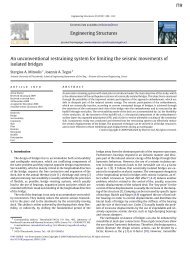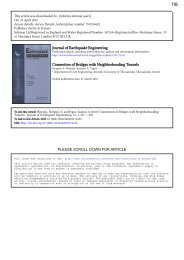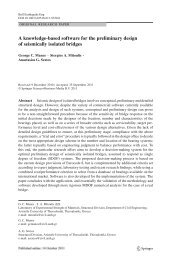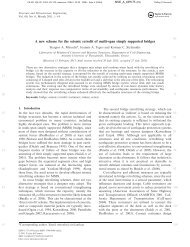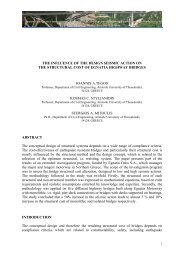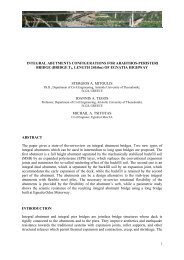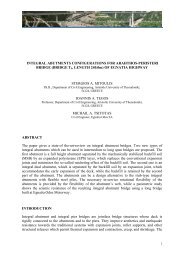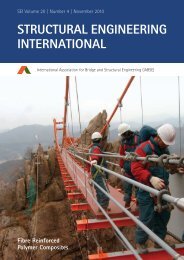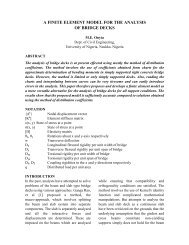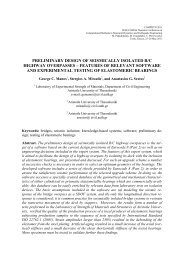18 Preliminary design of seismically isolated RC highway overpasses
You also want an ePaper? Increase the reach of your titles
YUMPU automatically turns print PDFs into web optimized ePapers that Google loves.
George C. Manos, Stergios A. Mitoulis and Anastasios G. Sextos<br />
It is evident that the prediction success <strong>of</strong> the preliminary <strong>design</strong> process, that is proposed<br />
here, heavily relies on the extent <strong>of</strong> the contribution <strong>of</strong> the fundamental mode in the longitudinal<br />
direction, which, when dominant, yields the SDOF simplification as reasonable assumption.<br />
To sum up, it is believed that: a) the criteria imposed regarding compression stress<br />
limits, which are complementary to the ones prescribed in the codes, b) the automation <strong>of</strong> the<br />
process achieved though the developed s<strong>of</strong>tware, which permits the investigation <strong>of</strong> hundreds<br />
<strong>of</strong> different bearing solutions, and c) the eligible bearing hierarchy provided through the proposed<br />
safety over cost (Optimal Performance) criterion, provide a significantly large number<br />
<strong>of</strong> potential <strong>design</strong> alternatives to be considered for the final selection. In this way, the proposed<br />
process can be seen as an effective preliminary <strong>design</strong> tool which is believed to lead to<br />
the quicker and more reliable estimate <strong>of</strong> the optimal bearing selection and seismic response<br />
<strong>of</strong> a <strong>highway</strong> overpass bridge either in the stage before its final <strong>design</strong> or when such an existing<br />
bridge is checked for upgrading its seismic performance utilizing such an isolation<br />
scheme.<br />
The extensive experimental sequence verified the quality <strong>of</strong> the production process <strong>of</strong> a local<br />
producer <strong>of</strong> elastomeric bearings by subjecting slices <strong>of</strong> these bearings, being sampled<br />
during production, to the loading sequence specified by the International Standard ISO<br />
22762-1 (2005). As can be concluded from these tests, for shear strain amplitudes lower than<br />
250%, the variation <strong>of</strong> the frequency and shear strain amplitude did not influence the stiffness<br />
and strength properties <strong>of</strong> the tested specimens. For strain amplitudes larger than 250% the<br />
prevailing mode <strong>of</strong> failure was that <strong>of</strong> the debonding <strong>of</strong> the elastomer from the steel plating.<br />
Next, the experimental investigation examined the cyclic shear strain performance <strong>of</strong> locally<br />
produced prototype elastomeric bearings by subjecting samples <strong>of</strong> such bearings to the test<br />
sequence specified by the same International Standard ISO 22762-1. This time, the influence<br />
<strong>of</strong> aging was also investigated. As can be deduced from the measured behavior, aging resulted<br />
in a small increase <strong>of</strong> the axial (vertical) stiffness and a small decrease <strong>of</strong> the shear (horizontal)<br />
stiffness <strong>of</strong> the tested elastomeric bearings. More specimens must be tested to validate further<br />
these findings.<br />
7 ACKNOWLEDGEMENTS<br />
This research was conducted in the framework <strong>of</strong> the Regional Innovation Pole <strong>of</strong> the Region<br />
<strong>of</strong> Central Macedonia in northern Greece which was established in 2006, in the city <strong>of</strong><br />
Thessaloniki. The project was funded by the General Secretariat <strong>of</strong> Research and Technology<br />
<strong>of</strong> the Greek Ministry <strong>of</strong> Development; its support is gratefully acknowledged. Ms. M. Geraki’s<br />
contribution in the parametric validation <strong>of</strong> the s<strong>of</strong>tware and the help <strong>of</strong> the personnel <strong>of</strong><br />
the Laboratory <strong>of</strong> Strength <strong>of</strong> Materials and Structures <strong>of</strong> Aristotle University <strong>of</strong> Thessaloniki<br />
during the experimental tests are also acknowledged. The authors also wish to thank P. Skalkos<br />
for his contribution to the development <strong>of</strong> this specific s<strong>of</strong>tware.<br />
REFERENCES<br />
[1] Pracasa R. A.V.N.S. BEAS: Expert system for the preliminary <strong>design</strong> <strong>of</strong> bearings. Technical<br />
Note. Advances in Engineering S<strong>of</strong>tware 1992; 14(2): 163-166.<br />
[2] Gavaise E, Papaefthimiou K, Tzaveas T, Stylianidis K, Tegos J. The problem <strong>of</strong> minimum<br />
cost for structural members <strong>of</strong> earthquake resistant bridges. In Proc. <strong>of</strong> 5th International<br />
Conference <strong>of</strong> Earthquake Resistant Engineering Structures. Skiathos 2005.<br />
[3] Naeim F, Kelly JM. Design <strong>of</strong> seismic <strong>isolated</strong> structures, From theory to practice. John<br />
Wiley and Sons, Inc; 1999.<br />
<strong>18</strong>






